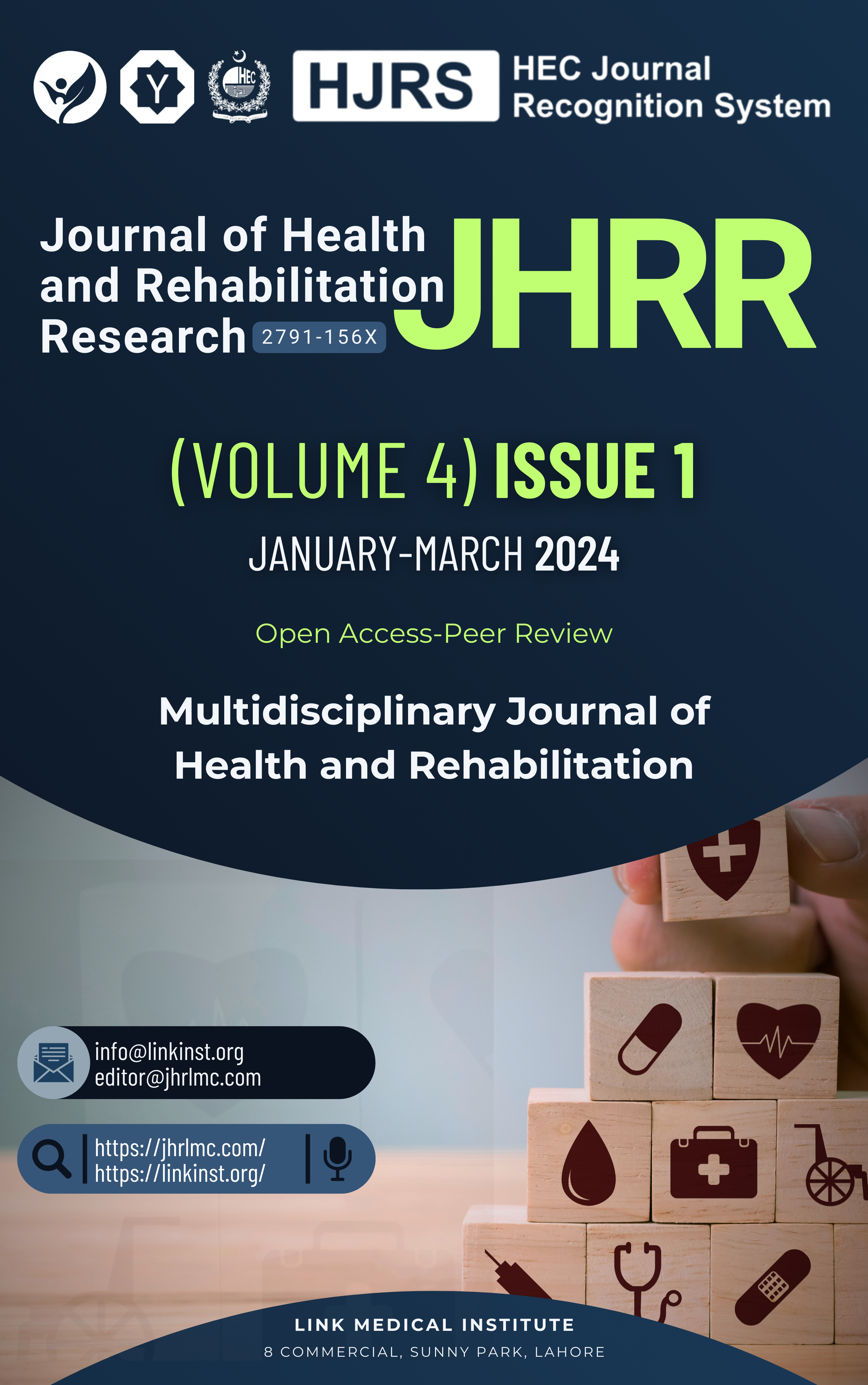Prevalence of Dequervains Tenosynovitis in 20-40 Years Old Mobile Users
DOI:
https://doi.org/10.61919/jhrr.v4i1.561Keywords:
DeQuervain's tenosynovitis, mobile users, gender differences, prevalence, ergonomic considerations, musculoskeletal disorders, Finkelstein test, Quick DASHAbstract
Background: The advent of mobile technology has revolutionized communication but has also introduced new health concerns, including DeQuervain's tenosynovitis (DQT), a condition affecting the thumb and wrist. Previous studies have reported varying prevalences of DQT among mobile users, with potential gender differences in susceptibility. This study seeks to add to the existing body of knowledge by exploring the prevalence of DQT among young adult mobile users and examining gender differences in the condition's occurrence.
Objective: To determine the prevalence of DeQuervain's tenosynovitis among mobile users aged 20–40 years and to investigate whether there are significant gender differences in the susceptibility to the condition.
Methods: This cross-sectional study involved 100 participants, stratified by gender, who regularly use mobile devices. Data were collected through self-administered questionnaires to assess mobile device usage patterns and symptoms of DQT. The Finkelstein test was used to diagnose DQT among participants. Statistical analysis included the calculation of prevalence rates, and the Pearson correlation coefficient was employed to explore the relationship between mobile device usage and symptoms of DQT. Gender differences were assessed using chi-square tests.
Results: Of the 100 participants, 52% tested positive for DeQuervain's tenosynovitis. Female mobile users demonstrated a higher prevalence (58%) compared to male mobile users (42%). The study also found a moderate positive correlation (r = 0.37, p = 0.001) between the extent of mobile device use and symptoms of DQT. The Quick DASH scores ranged from 12.0 to 45.00, with an average score of 17.75 ± 6.91, indicating variability in the impact of DQT on functional abilities.
Conclusion: The study confirms a high prevalence of DeQuervain's tenosynovitis among young adult mobile users, with a significant gender difference indicating higher susceptibility among females. These findings underscore the need for ergonomic considerations and preventive measures in the use of mobile devices to mitigate the risk of musculoskeletal disorders.
Downloads
References
Ma T, Song L, Ning S, Wang H, Zhang G, Wu Z. Relationship between the incidence of de Quervain’s disease among teenagers and mobile gaming. International Orthopaedics. 2019;43:2587-92.
Hetaimish B, Bossei A, Turkstani G, Al-Jezani K, Al-Motairi K. Prevalence of De-Quervain’s Tenosynovitis Among Medical Professionals. Middle East Journal of Family Medicine. 2020;7(10):125.
Mirzanli C, Ozturk K, Esenyel C, Ayanoglu S, Imren Y, Aliustaoglu S. Accuracy of intrasheath injection techniques for de Quervain’s disease: a cadaveric study. Journal of Hand Surgery (European Volume). 2012;37(2):155-60.
Clarke M, Lyall H, Grant J, Matthewson M. The histopathology of de Quervain’s disease. Journal of Hand Surgery. 1998;23(6):732-4.
Iqbal S, Khattak HG, Aman S, Anwar K, Ali B, Malakandi HB. Frequency of De-Quervain Syndrome in Mobile Users Among Undergraduate Students of Allied Health Sciences Peshawar. Foundation University Journal of Rehabilitation Sciences. 2021;1(1):15-8.
Benites-Zapata VA, Jiménez-Torres VE, Ayala-Roldán MP. Problematic smartphone use is associated with de Quervain's tenosynovitis symptomatology among young adults. Musculoskeletal Science and Practice. 2021;53:102356.
Ilyas AM, Ast M, Schaffer AA, Thoder J. De quervain tenosynovitis of the wrist. JAAOS-Journal of the American Academy of Orthopaedic Surgeons. 2007;15(12):757-64.
Morgan SD, Sivakumar BS, An VG, Sevao J, Graham DJ. A review of De Quervain’s stenosing tenovaginitis in the context of smartphone use. The Journal of Hand Surgery (Asian-Pacific Volume). 2020;25(02):133-6.
Ilyas N, Hanif F, Panjwani RK, Rahim SK, Qadeer AA, Hameed A. COMPARISON OF EFFICACY OF INJECTABLE STEROIDS VERSUS CONSERVATIVE MANAGEMENT FOR DE QUERVAINS’S TENOSYNOVITIS. Journal of University Medical & Dental College. 2021;12(3):217-21.
Eapen C, Kumar B, Bhat AK, Venugopal A. Extensor pollicis longus injury in addition to De Quervain’s with text messaging on mobile phones. Journal of clinical and diagnostic research: JCDR. 2014;8(11):LC01.
Sullivan KM, Dean A, Soe MM. OpenEpi: a web-based epidemiologic and statistical calculator for public health. Public health reports (Washington, DC : 1974). 2009;124(3):471-4.
Ali M, Asim M, Danish SH, Ahmad F, Iqbal A, Hasan SD. Frequency of De Quervain’s tenosynovitis and its association with SMS texting. Muscles, ligaments and tendons journal. 2014;4(1):74.
Taufiq F, Batool T, Bashir S. Prevalence of De-Quervain's Tenosynovitis among Medical Students of Allama Iqbal Medical College: JRCRS-2015, 3 (2): 95-98. Journal Riphah College of Rehabilitation Sciences. 2015;3(2):95-8.
Mallick SK, Jha DK, Majumdar A, Mahapatra S. A comparative study between splinting versus corticosteroid injection in de-quervain’s disease. Int J Orthop Sci. 2018;4(3.1):22-6.
Reada B, Alshaebi N, Almaghrabi K, Alshuaibi A, Abulnaja A, Alzahrani K. Prevalence and Awareness Evaluation of De Quervain’s Tenosynovitis among Students in the Kingdom of Saudi Arabia’. International Journal of Pharmaceutical Research & Allied Sciences. 2020;9(4):151-7.
Alsalameh AM, Harisi MJ, Alduayji MA, Almutham AA, Mahmood FM. Evaluating the relationship between smartphone addiction/overuse and musculoskeletal pain among medical students at Qassim University. Journal of family medicine and primary care. 2019;8(9):2953.
Le Manac'h AP, Roquelaure Y, Ha C, Bodin J, Meyer G, Bigot F, et al. Risk factors for de Quervain's disease in a French working population. Scandinavian journal of work, environment & health. 2011:394-401.
Wolf JM, Sturdivant RX, Owens BD. Incidence of de Quervain's tenosynovitis in a young, active population. The Journal of hand surgery. 2009;34(1):112-5.
Davey S, Davey A. Assessment of smartphone addiction in Indian adolescents: A mixed method study by systematic-review and meta-analysis approach. International journal of preventive medicine. 2014;5(12):1500.
Stahl S, Vida D, Meisner C, Stahl AS, Schaller H-E, Held M. Work related etiology of de Quervain’s tenosynovitis: a case-control study with prospectively collected data. BMC musculoskeletal disorders. 2015;16(1):1-10.
Downloads
Published
How to Cite
Issue
Section
License
Copyright (c) 2024 Muhammad Shahbaz Sharif, Muhammad Mahmood Alam, Muhammad Waseem Akhtar, Sidrah Shabbir, Muhammad Mustafa Gul, Ghania Asad

This work is licensed under a Creative Commons Attribution 4.0 International License.
Public Licensing Terms
This work is licensed under the Creative Commons Attribution 4.0 International License (CC BY 4.0). Under this license:
- You are free to share (copy and redistribute the material in any medium or format) and adapt (remix, transform, and build upon the material) for any purpose, including commercial use.
- Attribution must be given to the original author(s) and source in a manner that is reasonable and does not imply endorsement.
- No additional restrictions may be applied that conflict with the terms of this license.
For more details, visit: https://creativecommons.org/licenses/by/4.0/.






